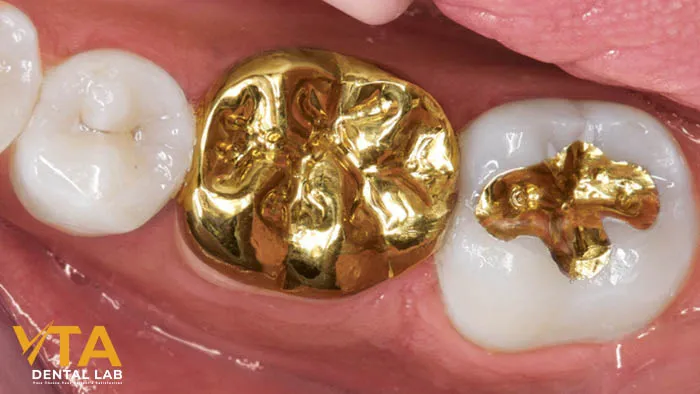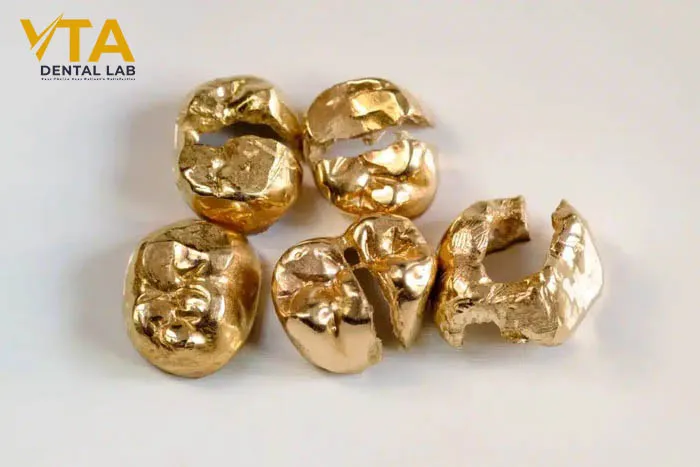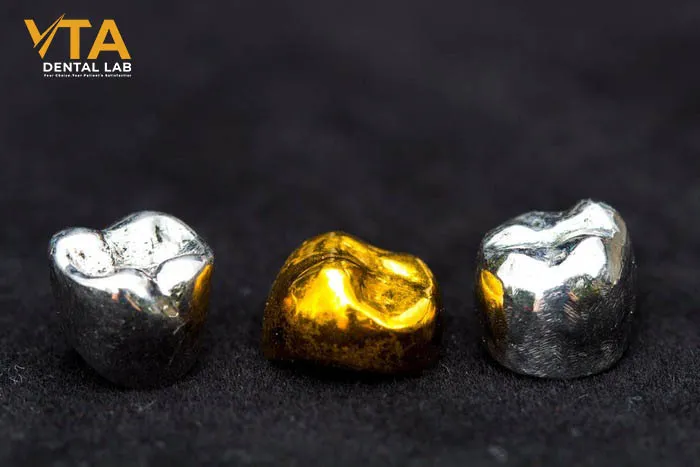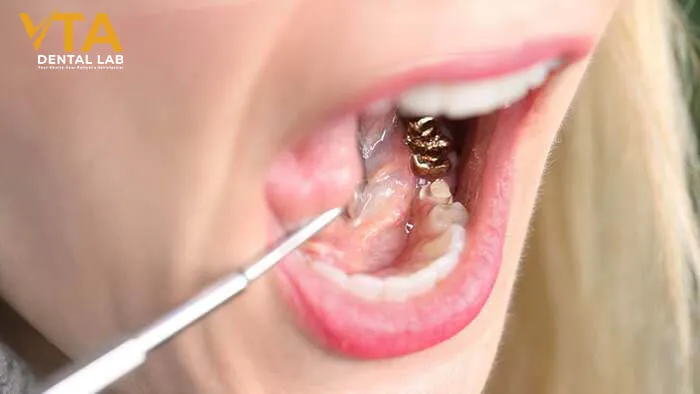Why a gold crown is worth the investment?
Gold has long been used in dental restorations. A gold crown is commonly used to restore a damaged tooth, such as one affected by cavities, fractures, or structural damage. This crown offers high durability and excellent biocompatibility, making it ideal for restoring a molar or a back tooth, which endures the greatest chewing forces. Read more in the article below.
What is a Gold Crown?
A gold crown, or gold alloy crown, is a dental restoration that helps protect damaged teeth. It serves to safeguard and restore the chewing function of the mouth. Gold crowns are highly resistant to wear and corrosion, securely fixed in place, and require minimal tooth preparation compared to other crown types, preserving more of the natural tooth structure.

Gold crowns also provide excellent marginal integrity, meaning they fit precisely over the tooth and create a tight seal that prevents bacteria and cavities from penetrating the tooth structure. Additionally, they have high biocompatibility with surrounding tissues, reducing the risk of allergic reactions or gum irritation. However, due to their metallic color, gold crowns are the least natural-looking option, making them ideal for less visible molars.
Features of a Gold Crown
Long-Lasting Durability
Gold is a noble metal with inert properties. It is resistant to corrosion and oxidation in the oral environment, even when exposed to acids and enzymes in saliva. A gold crown is also highly ductile and more resistant to fractures than many other dental materials. It can withstand strong chewing forces without cracking or breaking like some other alloys. Additionally, the elasticity of gold reduces the risk of fractures or cracks under continuous pressure.
Low Wear Rate
Gold has a wear rate similar to natural tooth enamel, preventing the crown from wearing down quickly during chewing. Its softness also makes it less likely to cause excessive wear on opposing teeth compared to porcelain or harder metal crowns.

Superior Biocompatibility
A gold crown offers high biocompatibility, reducing bacterial growth in the oral cavity. This is due to its highly polished surface and thin margins, which minimize bacterial adhesion. Studies have also shown that bacteria do not adhere to gold surfaces as easily as they do to some other dental materials.
Variety of Alloy Options
Full-cast gold crowns can be made from various alloys to meet individual aesthetic, durability, and financial needs. Common types include Noble Alloys and High Noble Alloys, which contain a high percentage of gold, enhancing durability, corrosion resistance, and biocompatibility. These alloys may appear white or yellow, depending on additional metals like palladium or platinum.

Additionally, Non-Precious Alloys are a more affordable option while still providing strength and wear resistance. Each alloy type offers unique advantages, allowing dentists and patients flexibility in choosing the most suitable restorative material.
Indications and Contraindications for a gold crown
Indications
A full-cast gold crown is an ideal choice for various dental restorations due to its high durability and excellent load-bearing capacity. It is recommended for single-unit crowns, providing protection and functional restoration for damaged fractured, or severely decayed teeth. Additionally, gold crowns are suitable for multi-unit bridges, especially in posterior restorations where high chewing forces demand superior strength.

Gold is also used in smaller restorations like inlays and onlays, which serve as an alternative to traditional fillings, preserving more of the natural tooth structure and extending the restoration’s lifespan. Thanks to its exceptional strength, biocompatibility, and wear resistance, a full-cast gold crown is an effective solution—particularly for molars, where durability is more critical than aesthetics.
Contraindications
A full-cast gold crown is not the best option for front teeth or aesthetic zones, where a natural appearance is essential to blend with surrounding teeth. Due to its metallic color (gold or white), a gold alloy crown may be visibly noticeable when smiling or speaking, affecting cosmetic appeal. In such cases, all ceramic or porcelain-fused-to-metal crowns (PFM) are often preferred for a more natural look.
Additionally, patients with a history of allergies to alloy components such as nickel, palladium, or other metals used in dental materials should avoid gold crowns. Allergic reactions may lead to gum inflammation, soft tissue irritation, or other oral health issues. Therefore, it is crucial to review the patient’s allergy history before selecting the appropriate alloy to prevent unwanted side effects.
Benefits of Choosing a Gold Crown
Long Lifespan
Gold crowns can last 30-40 years or even longer with proper care. Due to their high mechanical strength and excellent corrosion resistance, gold crowns are among the longest-lasting dental restorations available.
Plaque Resistance
The smooth, polished surface of a gold crown helps reduce plaque and bacterial buildup, lowering the risk of cavities and gum disease. This characteristic contributes to better oral health compared to some other materials.
High Marginal Integrity and Durability
Gold crowns can be crafted with thin margins while still ensuring a solid fit, tightly hugging the natural tooth and reducing the risk of bacterial infiltration. Additionally, the malleability of gold helps create a tight seal, minimizing the chance of breakage and maintaining long-term chewing efficiency.
Thanks to these advantages, gold crowns remain the top choice for posterior restorations, especially for patients who prioritize durability and oral health over aesthetics.

Preparing a Tooth for a Gold Crown
The process of tooth preparation for a full-cast gold crown must follow specific technical guidelines to ensure durability, accurate occlusion, and a perfect fit:
Occlusal/Incisal Reduction: Approximately 1.5 mm should be reduced from the biting surface to create enough space for the crown while maintaining strength and chewing function.
Facial/Lingual Reduction: Around 1.2 mm should be reduced on the outer and inner surfaces to ensure the crown fits snugly and does not cause discomfort when placed on the natural tooth.
Cervical Reduction: Around 1.0 mm should be reduced at the tooth’s cervical area to create a secure contact point between the crown and the natural tooth. However, a “knife-edge” margin preparation can also be used to ensure a precise fit without removing too much natural tooth structure.
Following these guidelines ensures that the gold crown has high durability, and long-term stability, and maintains the health of the surrounding periodontal tissues.
If you experience any issues with fit, contact the laboratory directly to discuss your case with our technical team. The VTA technical team is always available to resolve any restoration-related issues and work directly with your practice to provide the best solutions.